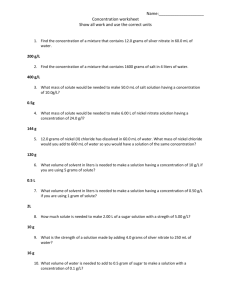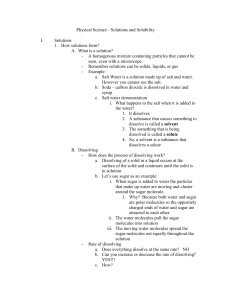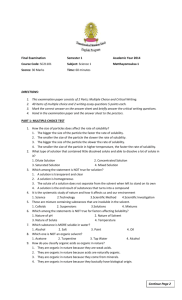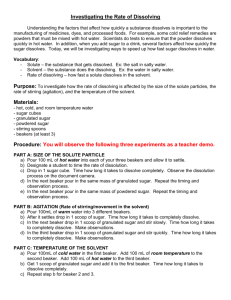Types of Solutions Lab Worksheet - Chemistry
advertisement
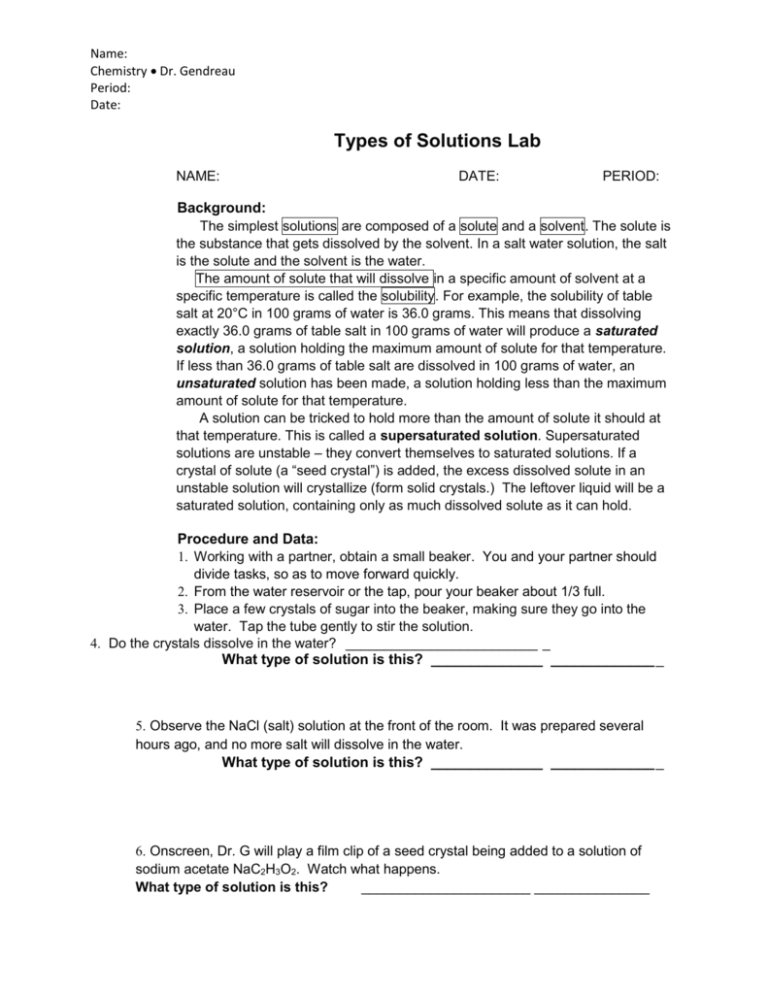
Name: Chemistry Dr. Gendreau Period: Date: Types of Solutions Lab NAME: DATE: PERIOD: Background: The simplest solutions are composed of a solute and a solvent. The solute is the substance that gets dissolved by the solvent. In a salt water solution, the salt is the solute and the solvent is the water. The amount of solute that will dissolve in a specific amount of solvent at a specific temperature is called the solubility. For example, the solubility of table salt at 20°C in 100 grams of water is 36.0 grams. This means that dissolving exactly 36.0 grams of table salt in 100 grams of water will produce a saturated solution, a solution holding the maximum amount of solute for that temperature. If less than 36.0 grams of table salt are dissolved in 100 grams of water, an unsaturated solution has been made, a solution holding less than the maximum amount of solute for that temperature. A solution can be tricked to hold more than the amount of solute it should at that temperature. This is called a supersaturated solution. Supersaturated solutions are unstable – they convert themselves to saturated solutions. If a crystal of solute (a “seed crystal”) is added, the excess dissolved solute in an unstable solution will crystallize (form solid crystals.) The leftover liquid will be a saturated solution, containing only as much dissolved solute as it can hold. Procedure and Data: 1. Working with a partner, obtain a small beaker. You and your partner should divide tasks, so as to move forward quickly. 2. From the water reservoir or the tap, pour your beaker about 1/3 full. 3. Place a few crystals of sugar into the beaker, making sure they go into the water. Tap the tube gently to stir the solution. 4. Do the crystals dissolve in the water? _________________________ _ What type of solution is this? ______________ _____________ _ 5. Observe the NaCl (salt) solution at the front of the room. It was prepared several hours ago, and no more salt will dissolve in the water. What type of solution is this? ______________ _____________ _ 6. Onscreen, Dr. G will play a film clip of a seed crystal being added to a solution of sodium acetate NaC2H3O2. Watch what happens. What type of solution is this? ______________________ _______________ Name: Chemistry Dr. Gendreau Period: Date: 7. Temperature affects the speed with which dissolving takes place, because the speed of solvent molecules’ motion in the liquid is temperature-related, like gas molecule speeds and for the same reason. Do this with another pair of students: Put ice cold water (from the bucket) in one pair’s beaker and hot water (from the sink tap) in the other. Get four sugar cubes and a plastic weighing dish from up front; you will use these for two experiments. Back at your station, set your beakers on the benchtop. Add one sugar cube to each beaker and observe what happens for several minutes. Write a complete sentence about how temperature and WHY the speed of dissolving are related: ________________________________________________________________ ________________________________________________________________ 8. A solid added to a solvent will dissolve from the outside inward, because the solvent molecules can contact (and dissolve) only the solid’s outer layer of particles. Therefore, the solid’s surface area affects how fast it dissolves. One person should rinse your two beakers in the sink and add room temperature tap water to each. At your station, another person crushes one of your two remaining sugar cubes in the plastic weighing dish. The smaller pieces will have the same mass as a cube, but more surface area. Put the crushed sugar in one beaker and the cube in the other. Observe what happens. Write a complete sentence about how AND WHY surface area and solubility speed are related: ________________________________________________________________ ________________________________________________________________ 9. Near a dissolving solute’s surface, the solvent will be saturated with dissolved solute particles. That saturated solvent will have to move away to allow fresh solvent to get to the crystals. If solid sugar is left in one beaker, swirl it gently to bring fresh solvent in contact with the sugar surface. Observe what happens. Write a complete sentence about how and why stirring and solubility speed are related: ______________________________________________________________________ ______________________________________________________________________ 10: Clean up: rinse your beakers in the sink and replace them upside down on the tray. Wipe off your weighing boat with a dry paper towel (don’t wet it) and put it back on its tray. Pick up a copy of the Lab Worksheet from Dr. Gendreau and start your homework.

